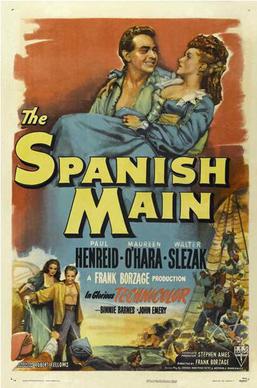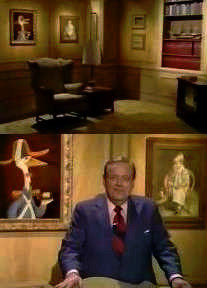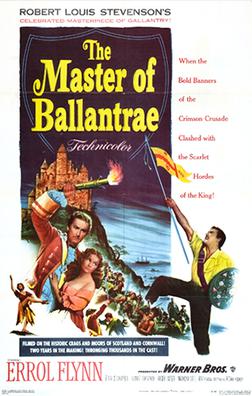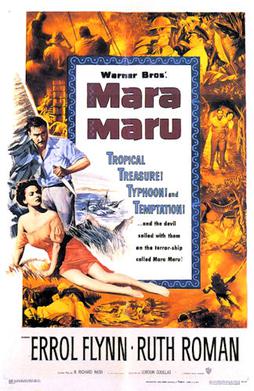
Captain Blood is a 1935 American black-and-white swashbuckling pirate film from First National Pictures and Warner Bros. Pictures, produced by Harry Joe Brown and Gordon Hollingshead, directed by Michael Curtiz and starring Errol Flynn, Olivia de Havilland, Basil Rathbone, and Ross Alexander.

Errol Leslie Thomson Flynn was an Australian actor who achieved worldwide fame during the Golden Age of Hollywood. He was known for his romantic swashbuckler roles, frequent partnerships with Olivia de Havilland, and reputation for his womanising and hedonistic personal life. His most notable roles include Robin Hood in The Adventures of Robin Hood (1938), which was later named by the American Film Institute as the 18th greatest hero in American film history, the lead role in Captain Blood (1935), Major Geoffrey Vickers in The Charge of the Light Brigade (1936), and the hero in a number of Westerns such as Dodge City (1939), Santa Fe Trail (1940), and San Antonio (1945).

Maureen O'Hara was an Irish-born naturalized American actress and singer, who became successful in Hollywood from the 1940s through to the 1960s. She was a natural redhead who was known for playing passionate but sensible heroines, often in Westerns and adventure films. She worked with director John Ford and long-time friend John Wayne on numerous projects.

Rio Grande is a 1950 American romantic Western film directed by John Ford and starring John Wayne and Maureen O'Hara. It is the third installment of Ford's "Cavalry Trilogy", following two RKO Pictures releases: Fort Apache (1948) and She Wore a Yellow Ribbon (1949). Wayne plays the lead in all three films, as Captain Kirby York in Fort Apache, then as Captain Nathan Brittles in She Wore a Yellow Ribbon, and finally as a promoted Lieutenant Colonel Kirby Yorke in Rio Grande. Rio Grande's supporting cast features Ben Johnson, Claude Jarman Jr., Harry Carey Jr., Chill Wills, J. Carrol Naish, Victor McLaglen, Grant Withers, the Western singing group the Sons of the Pioneers and Stan Jones.
George Sherman was an American film director and producer of low-budget Western films. One obituary said his "credits rival in number those of anyone in the entertainment industry."

The Spanish Main is a 1945 American adventure film starring Paul Henreid, Maureen O'Hara, Walter Slezak and Binnie Barnes, and directed by Frank Borzage. It was RKO's first all-Technicolor film since Becky Sharp ten years before.

Roche Braziliano was a Dutch Brazilian pirate born in the town of Groningen. His pirate career lasted from 1654 until his disappearance around 1671. He was first made famous in Alexandre Exquemelin's 1678 book The Buccaneers of America; Exquemelin did not know Braziliano's real name, but historians have found he was probably born as Gerrit Gerritszoon and that he and his parents moved to Dutch-controlled Brazil. He is known as "Roche Braziliano", which in English translates to "Rock the Brazilian", due to his long exile in Brazil.

The Black Swan is a 1942 American swashbuckler Technicolor film directed by Henry King and starring Tyrone Power and Maureen O'Hara. It was based on the 1932 novel of the same title by Rafael Sabatini.

Kim is a 1950 adventure film made in Technicolor by Metro-Goldwyn-Mayer. It was directed by Victor Saville and produced by Leon Gordon from a screenplay by Helen Deutsch, Leon Gordon and Richard Schayer, based on the classic 1901 novel of the same name by Rudyard Kipling.

In English-speaking popular culture, the modern pirate stereotype owes its attributes mostly to the imagined tradition of the 18th-century Caribbean pirate sailing off the Spanish Main and to such celebrated 20th-century depictions as Captain Hook and his crew in the theatrical and film versions of J. M. Barrie's children's book Peter Pan, Robert Newton's portrayal of Long John Silver in the 1950 film adaptation of the Robert Louis Stevenson novel Treasure Island, and various adaptations of the Middle Eastern pirate, Sinbad the Sailor. In these and countless other books, films, and legends, pirates are portrayed as "swashbucklers" and "plunderers". They are shown on ships, often wearing eyepatches or peg legs, having a parrot perched on their shoulder, speaking in a West Country accent, and saying phrases like "Arr, matey" and "Avast, me hearty". Pirates have retained their image through pirate-themed tourist attractions, film, toys, books and plays.

Adventures of Don Juan is a 1948 American Technicolor swashbuckling adventure romance film directed by Vincent Sherman and starring Errol Flynn and Viveca Lindfors, with Robert Douglas, Alan Hale, Ann Rutherford, and Robert Warwick. Also in the cast are Barbara Bates, Raymond Burr, and Mary Stuart. The film was distributed by Warner Bros. and produced by Jerry Wald. The screenplay by George Oppenheimer and Harry Kurnitz, based on a story by Herbert Dalmas, has uncredited contributions by William Faulkner and Robert Florey.

Swashbuckler films are a subgenre of the action film genre, characterised by swordfighting and adventurous heroic characters, known as swashbucklers. While morality is typically clear-cut, heroes and villains alike often follow a code of honour. Some swashbuckler films have romantic elements, most frequently a damsel in distress. Both real and fictional historical events often feature prominently in the plot.

Family Classics is a Chicago television series which began in 1962 when Frazier Thomas was added to another program at WGN-TV. Thomas not only hosted classic films, but also selected the titles and personally edited them to remove those scenes which he thought were not fit for family viewing. After Thomas' death in 1985, Roy Leonard took over the program. The series continued sporadically until its initial cancellation in 2000.

The Master of Ballantrae is a 1953 British Technicolor adventure film starring Errol Flynn and Roger Livesey. It is a loose and highly truncated adaptation of the Robert Louis Stevenson 1889 novel of the same name. In eighteenth century Scotland, two sons of a laird clash over the family estate and a lady.

Rocky Mountain is a 1950 American Western film directed by William Keighley and starring Errol Flynn. It also stars Patrice Wymore, who married Flynn in 1950. The film is set in California near the end of the American Civil War.

War Arrow is a 1954 American Technicolor Western film directed by George Sherman and starring Maureen O'Hara, Jeff Chandler and John McIntire. Filmed by Universal Pictures and based on the Seminole Scouts, the film was shot in Agoura, California.

Adventures of Captain Fabian or Adventure in New Orleans is a 1951 American adventure film directed by William Marshall and starring Errol Flynn, Micheline Presle, Vincent Price, Agnes Moorehead and Victor Francen.

Mara Maru is a 1952 American noir action film starring Errol Flynn, Ruth Roman and Raymond Burr. Directed by Gordon Douglas, it was the last movie Flynn made for Warner Bros where he had started out in Hollywood in 1935.

Montana is a 1950 American Western film directed by Ray Enright and starring Errol Flynn. It was only the second time Flynn played an Australian on screen, the first time being Desperate Journey (1942).

Last of the Buccaneers is a 1950 American Technicolor adventure film directed by Lew Landers and starring Paul Henreid as Jean Lafitte.




















